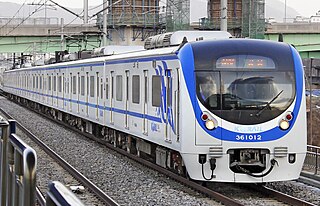
The Gyeongchun Line is a regional rail line between Seoul and Chuncheon, South Korea, operated by Korail. Its name is derived from Gyeong and Chuncheon. It was completely reconstructed in the 2000s. Service on it has operated between Sangbong station on the Jungang Line in eastern Seoul and Chuncheon station, as part of the Seoul Metropolitan Subway system, since December 21, 2010. A class of regional rail service named ITX-Cheongchun began operations on February 28, 2012, linking Chuncheon to Cheongnyangni and Yongsan Stations.

The Gyeongui Line is a railway line between Seoul Station and Dorasan Station in Paju. Korail operates the Seoul Metropolitan Subway service between Seoul Station and Dorasan Station.
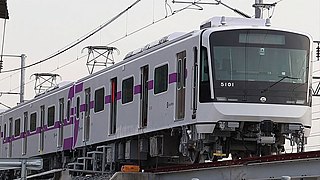
Seoul Subway Line 5 of the Seoul Metropolitan Subway, dubbed the purple line, is a long line crossing from west to the east across the Seoul National Capital Area, South Korea. It is one of two subway lines in Seoul to cross under the Han River, which is done at two points. The main line runs through to Hanam Geomdansan Station while the branch line from Gangdong Station terminates at Macheon Station. In 2019, Line 5 carried an annual ridership of 334 million or about 915,000 passengers per day.

Seoul Subway Line 7 of the Seoul Metropolitan Subway was built from 1990 to 1996 and was completed on August 1, 2000 ; the western section between Sinpung and Onsu was put into service on February 29, 2000. This north-south line does not run through the city centre but links Gangnam directly to the northeastern districts of Seoul. In 2019, Line 7 had an annual ridership of 380 million or 1.04 million passengers per day. Although most trains run between Jangam and Seongnam, some trains short turn at Onsu station and some trains start at Dobongsan station.

Seoul Subway Line 8 of the Seoul Metropolitan Subway was built from 1990 to 1999 and mainly serves the southeastern parts of Seoul and Seongnam. The first section from Jamsil to Moran opened in 1996, and the second section from Moran to Amsa was opened in July 1999. The line color is rose. In 2019, Line 8 had an annual ridership of 112 million or about 307,000 people per day. At 17.7 km (11.0 mi) in length, Line 8 is the shortest of all heavy rail Seoul Metropolitan Subway lines.

Seoul Subway Line 9, operated by Seoul Line9 Operation, is a subway line in Seoul, part of the Seoul Metropolitan Subway. The line runs east from Gaehwa station or Gimpo International Airport station along the south bank of the Han River towards VHS Medical Center in Gangdong. In 2019, Line 9 had an annual ridership of 225 million or about 616,000 people per day.

Wangsimni Station is a station on Seoul Subway Line 2, Seoul Subway Line 5, Gyeongui–Jungang Line, and Suin–Bundang Line; most Suin–Bundang Line trains end service here, though a few daily services continue along the tracks used by the Gyeonggi-Jungang line to terminate at the next station, Cheongnyangni in northeastern Seoul. It is located in Haengdang-dong, Seongdong-gu, Seoul.
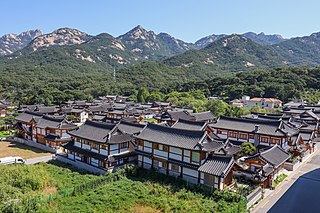
Eunpyeong District is one of the 25 districts of Seoul, South Korea.

The Honam high-speed railway, also known as Honam HSR, is a high-speed rail between Osong and Mokpo in South Korea. The line is a part of Korail's Korea Train Express (KTX) system, accelerating Seoul–Mokpo and Seoul–Gwangju KTX high-speed services which currently use the existing conventional Honam Line. On April 1, 2015, the line was inaugurated by the South Korean President Park Geun-hye with the attendance of 1200 invited guests and members of the public at Gwangju Songjeong Station in Gwangju, the line's terminus. The line diverges from Osong station on the Gyeongbu high-speed railway, and stops at Gongju, Iksan, Jeongeup Stations. Journey times between Seoul and Gwangju has been cut from 2 h 40 min to just 90 min, making daily commuting possible. The Honam HSR is intended to bring business, and economic opportunities to the province of Jeollanam-do, which has seen slower development than other parts of South Korea. The line has been open to the public since April 2, 2015 for revenue service.

Korea University Station is a subway station on the Seoul Subway Line 6. This station is located in front of the main entrance of Korea University.
The Seoul City in South Korea plans to build up to ten new light metro, or light rapid transit (LRT). They would be connected to the Seoul Metropolitan Subway giving access to several hundred subway stations. As opposed to traditional subway lines, LRT lines have a lower capacity.

Gusan-dong is a dong (neighborhood) of Eunpyeong District, Seoul, South Korea.

The Ansan Line is a railway line connecting Gunpo to Siheung in South Korea. Services on this line run through train services into Seoul Subway Line 4 via the Gwacheon Line. Services from the Suin Line share tracks with this line between Hanyang Univ. (Ansan)–Oido.

Digital Media City Station (Korean: 디지털미디어시티역) is a railway station on Seoul Subway Line 6, AREX and the Gyeongui–Jungang Line. The former names of this station were Multimedia City Station (멀티미디어시티역) for the AREX station and Susaek (수색) for the Line 6.
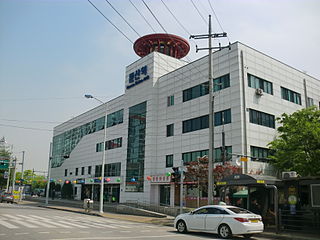
Munsan Station (Korean: 문산역) is a railway station on the Gyeongui–Jungang Line. It is notable for being the closest station on the Seoul Metropolitan Subway to the border with North Korea that is open for passenger service, only a few kilometers away.

Olympic Park is a subway station on Seoul Subway Line 5 and Seoul Subway Line 9 in Songpa-gu, Seoul. It became an interchange with Subway Line 9 on December 1, 2018.

Dokbawi Station is a railway station on Line 6 of the Seoul Metropolitan Subway in Eunpyeong District, Seoul, South Korea. This station is part of a one-way section of Line 6 known as the Eungam Loop. It is located in a relatively low-density area, and only has one exit.
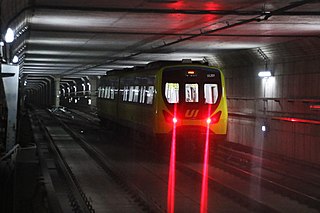
The Ui LRT, referred to as the Ui-Sinseol LRT or Ui-Sinseol Line (우이신설선) in Korean, is a light metro which is part of Seoul Metropolitan Subway. It is a fully underground 11.4 km (7.1 mi) Light Rapid Transit line from Ui-dong to Sinseol-dong in northern Seoul which opened on September 2, 2017. The line, which is expected to carry 110,000 passengers a day, has 13 stations. It connects to Line 4 at Sungshin Women's University, Line 6 at Bomun and Lines 1 & 2 at Sinseol-dong. The last (northernmost) station is in Ui-dong, hence the name of the line. In 2019, the line carried 27 million passengers or about 75,000 people per day.

Bundang (Korean: 분당) is a planned community in the Bundang District district of Seongnam, South Korea. It was developed to encourage affordable housing and urban decentralization. The community has a sports complex, a park and a youth center.
The Gangbukhoengdan line is a proposed light metro line scheduled to open in 2028, in Seoul, South Korea. In June 2024, the Ministry of Economy and Finance rejected the proposal on economic feasibility concerns due to high cost and low population density along the line.



















